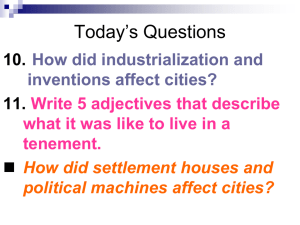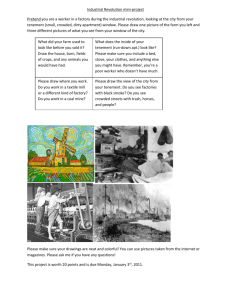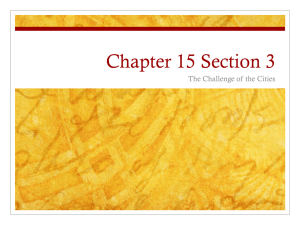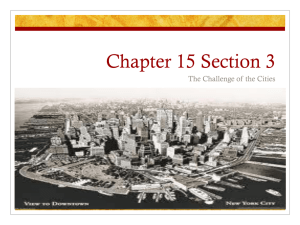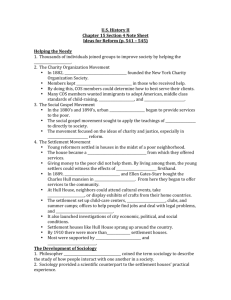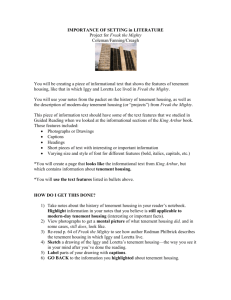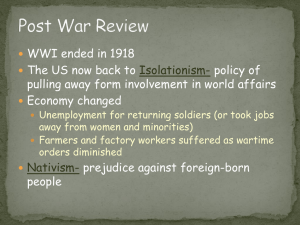settlement houses - Londonderry School District
advertisement
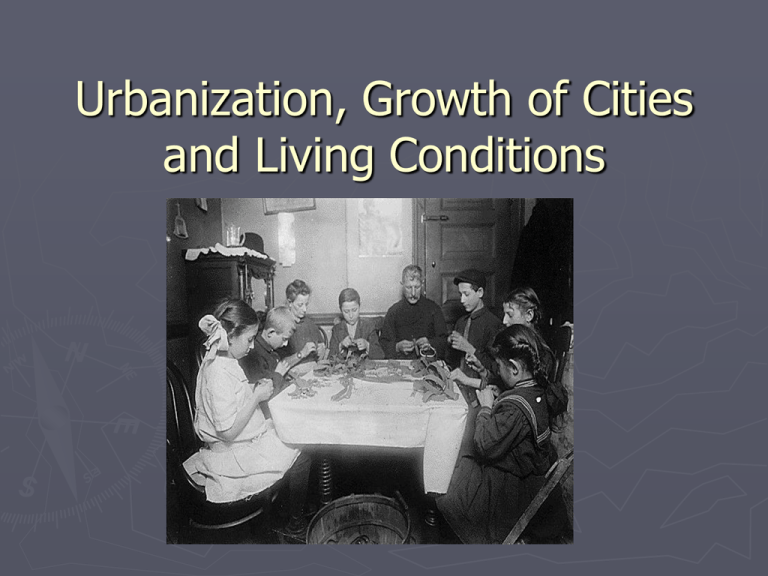
Urbanization, Growth of Cities and Living Conditions What trend to see you occurring throughout the almost 200 years? Urban Growth: 1870 - 1900 What was it like here for them? ► Some native-born Americans feared and resented the new immigrants. ► Their languages, religions, and customs seemed strange. ► They also competed for jobs. ► Desperate for jobs, immigrants often accepted lower wages and worse working conditions. ► The majority of immigrants settled in the big cities where factory jobs were available. By 1900, 4 out of every 5 people in New York City were immigrants or children of immigrants. Keeping the Culture Alive ► ► ► ► Seeking familiar surroundings, immigrants tended to live and work with people from their native country. Although their children attended public schools and quickly learned English, immigrant parents continued to use their native tongue Whether nicknamed Little Italy, Little Bohemia, or Chinatown, immigrant neighborhoods were rich with Old World languages, from the words printed in the newspaper or heard on the streets. These neighborhoods were terribly overcrowded, unfortunately contributing to poverty, crime, and disease. Mulberry Street – “Little Italy” Hester Street – Jewish Section When They Arrived… Where Did They Live? Tenement Buildings ► Many immigrants lived in crowded tenement buildings. ► Families shared living space and decent lighting & fresh air were scarce. ► People congregated outside, made heavy use of the fire escapes, and slept in summer on fire escapes, roofs, and sidewalks to get air ► * Layout of an Early Tenement Building Design of the building, which looked like a dumbbell, had many housing units sharing a corridor In Their Opinion ► It was a complete disaster. ► As House and Garden magazine wrote, "The dumbbell block is perhaps the worst type of tenement ever allowed in a modern, enlightened community. The halls and ten of the fourteen rooms on each floor are dark and illventilated, dependent for light and air solely upon narrow airshafts which give little or no light below the top floors." Back of a Tenement Overhead of tenement layout Inside a tenement house Living Conditions Conditions were uncomfortable, crowed, and dirty. ► In New York, 1,231 people lived in only 120 rooms in one part of the city. ► In Chicago in one year, over 60% of newborns never reached their first birthdays. ► Many babies asphyxiated in their own homes. ► Crowded life in tenement 2 <> Garbage was disposed of in boxes set in front of the house. A particularly lurid description of what some garbage boxes contained was printed in the New York Tribune in 1863: “Composed of potato-peelings, oyster-shells, night-soil, rancid butter, dead dogs and cats, and ordinary black street mud, (the garbage boxes formed) one festering, rotting, loathsome, hellish mass of air poisoning, death- breeding filth, reeking in the fierce sunshine, which gloats yellowy over it like the glare of a devil whom Satan has kicked from his councils in virtuous disgust." Alley between Tenements “Five Cents a Spot” Rooms ► ► ► Many immigrants had no home and slept in 5 cents a spot rooms where people paid for a small space to spend the night. Illegal housing quarters Both the provider and seeker were desperate Jacob Riis: How the Other Half Lived (1890) ► Newspaper reporter, social reformer, and photographer ► Shocked the U.S. conscience in 1890 with a factual description of slum conditions Excluded from the melting pot ► “Melting Pot”: immigrants assimilated into culture through education and acculturation. ► Does not correspond with reality of U.S. experience. ► Many immigrant groups maintained their ethnic identity. ► Melting pot did not take into account immigrants and ethnic groups who did not easily blend into the culture. ► Asians, African Americans, Native Americans, and others were excluded from this process of fusion and amalgamation. Main Idea 2: People worked to improve the quality of life in U.S. cities. ► Many private organizations stepped in to help the poor. ► Reformer Lawrence Veiller led an effort to improve tenement conditions through the Charity Organization Society. Helped to get the 1901 New York State Tenement House Act passed ► Some individuals set up settlement houses, or neighborhood centers in poor areas that offered education, recreation, and social activities. Settlement Houses ► One of the most famous settlement houses was Hull House Founded in Chicago in 1889 by reformers Jane Addams and Ellen Gates Starr ► Florence Kelley, a reformer at Hull House, visited sweatshops and wrote about the problems there. Convinced lawmakers to take action and in 1893, Illinois passed a law to limit working hours for women and to prevent child-labor Became Illinois’s chief factory inspector and helped to enforce the law ► Settlement houses continued to provide programs and services through the 1900s. Settlement Houses ► One of the most famous settlement houses was Hull House Founded in Chicago in 1889 by reformers Jane Addams and Ellen Gates Starr ► Florence Kelley, a reformer at Hull House, visited sweatshops and wrote about the problems there. Convinced lawmakers to take action and in 1893, Illinois passed a law to limit working hours for women and to prevent child-labor Became Illinois’s chief factory inspector and helped to enforce the law ► Settlement houses continued to provide programs and services through the 1900s.
